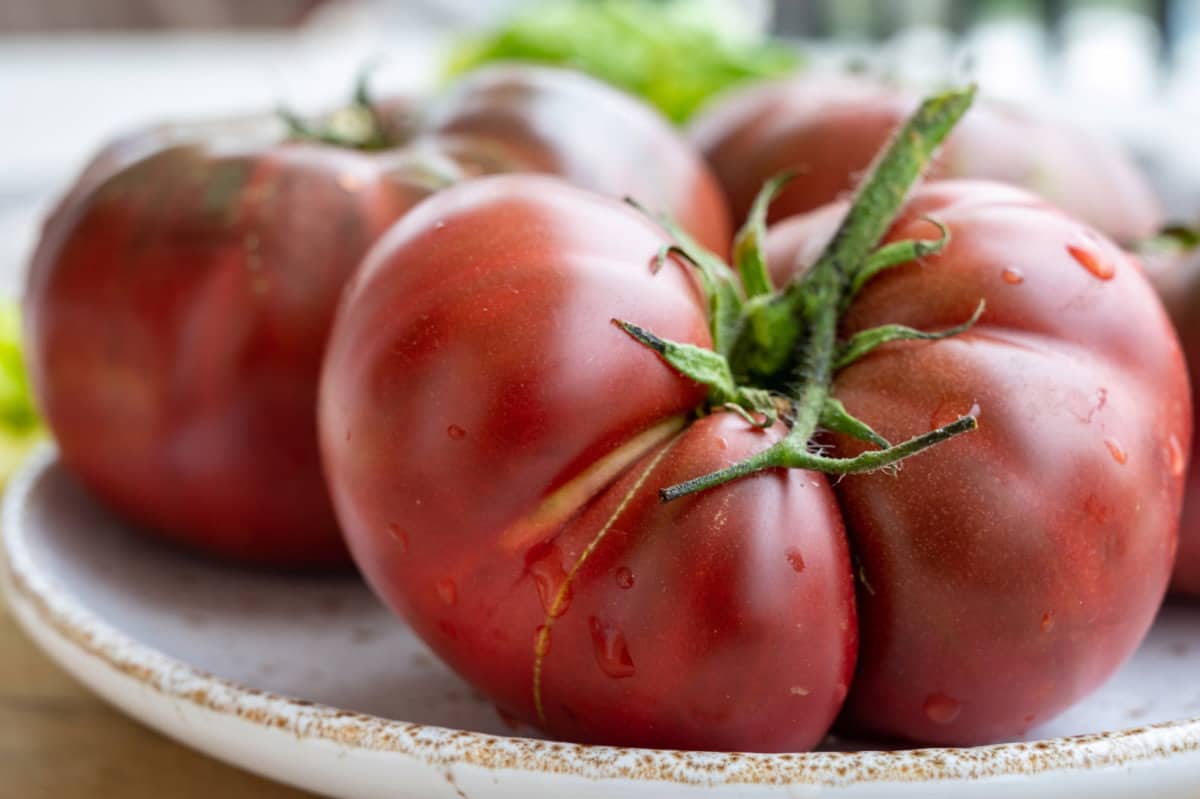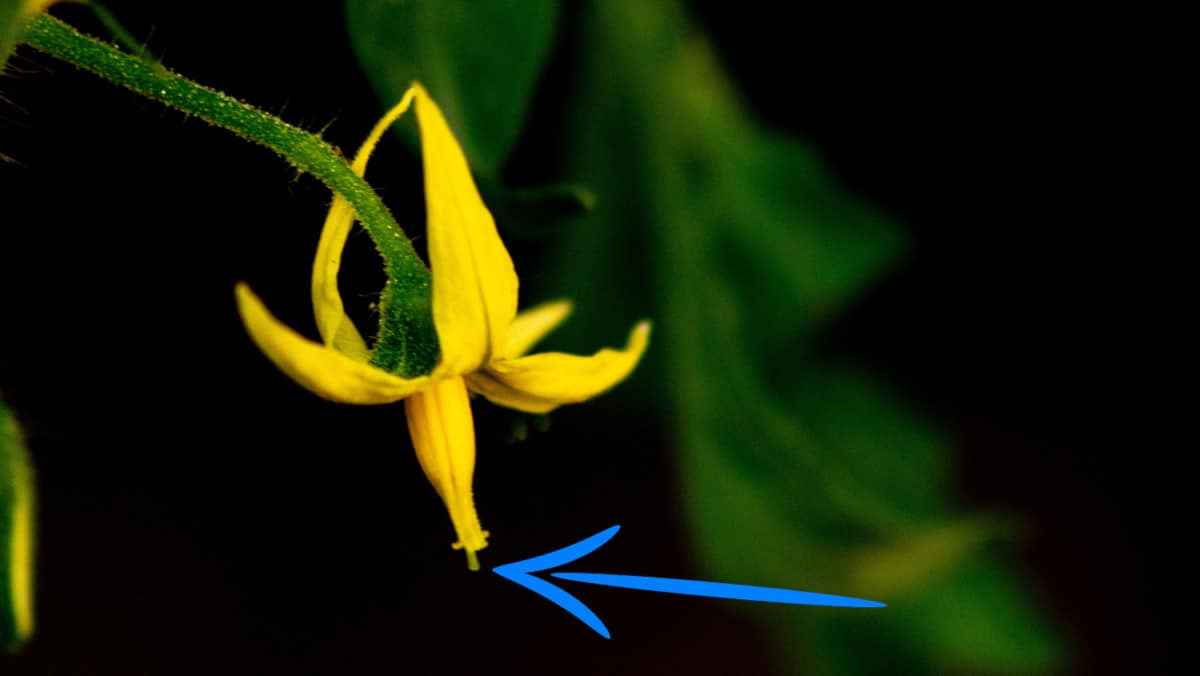Enjoying homegrown tomatoes picked off the vine is one of the simple pleasures of the summer garden. Growing your own tomatoes also lets you try rare or more flavorful heirloom varieties which you can only find in farmers markets.
Read below for answers to some of the common questions about heirloom tomatoes.
On this page:
Are Heirloom Tomatoes Organic?
Both heirloom tomatoes and hybrid tomatoes can be grown organically, or with chemical pesticides and fertilizers. Their seeds can also be produced organically.
As grocery produce, heirloom tomatoes can technically be grown with chemical pesticides and fungicides, so don’t assume they are organic unless explicitly labeled organic. “Heirloom” just means that it’s a stable, open-pollinated (non-hybrid) variety that has been grown for generations.
Read More: Facts and Questions About Heirloom, Open-Pollinated, and Hybrid Seeds
Are Heirloom Tomatoes Non-GMO?
All heirloom tomatoes and all consumer-available hybrid tomatoes are non-GMO.
Although there is research being done on genetically modifying tomatoes, there are currently no GMO tomatoes on the market in the United States, either as seed or produce. According to the FDA, most of the crops grown and sold as GMO are soybeans, corn, sugar beets, canola, and cotton. For example, over 90% of corn and soybeans grown in the US are GMO.
Heirloom tomatoes are non-GMO, and so are hybrid tomatoes, which are bred using conventional cross-pollination techniques and no direct gene modification.
Why Aren’t Hybrids GMO?
Hybrid tomatoes are not GMO because they are the result of cross-pollinating two stable parent varieties. While some major companies may use molecular genetic tools to track which traits are in the parent lines and hybrid, there is no direct genetic manipulation of hybrid tomatoes.
In contrast, the development of GMO crops involves directly manipulating genes (such as inserting genes from one species to another) to create a new or improved variety. As mentioned above, there are no GMO tomatoes on the market now in the US, but other major crops, like soybeans and corn, are mostly GMO.
What Do Heirloom Tomatoes Taste Like?
Heirloom tomatoes come in a wider variety of flavors than grocery store hybrids, ranging from sweet and tangy to smoky and savory. Many heirloom tomato varieties are also renowned for their richer flavor. While there are some hybrids bred to have rich, heirloom-like flavor, such as the Chef’s Choice varieties, many gardeners prefer the taste of heirlooms over hybrids.
In general, tomatoes vary in sweetness (sugar), tartness (acid), and savoriness (umami). Some are balanced, others are much sweeter, and then you have really savory, naturally salty tomatoes. Heirloom tomatoes can have other nuanced flavors like smokiness or fruitiness.
Sweet and tangy: Many intensely flavored heirloom cherry tomatoes are sweet and tangy. They’re great eaten as they are, added to salads, or cooked to further deepen their flavors. Examples: Barry’s Crazy Cherry, Chadwick Cherry, Isis Candy, Yellow Pear
Light and fruity: These tomatoes have a more mild flavor, with less acid, and are more on the sweet and fruity side but can also be mildly tart. They tend to be pale yellow or white, but some orange varieties can have a mild taste, too. Because their mild taste can be overpowered by vinaigrettes and sauces, they’re best enjoyed for fresh eating or in a tomato sandwich. Examples: White Tomesol, Great White Tomato, Dad’s Sunset
Rich and savory: Most dark (black/purple) tomatoes and many red tomatoes can have an intense yet savory flavor. Some can also be quite sweet, too. These tomatoes are great on their own, but are also perfect for salads, sauces, or stellar tomato sandwiches. Examples: Cherokee Purple, Black Krim, Carbon, Black Cherry, Paul Robeson
Good, old-fashioned tomato flavor: These heirloom tomatoes may not be the sweetest, most savory, or intensely flavored, but they have excellent flavor and hearken back to the days when tomatoes tasted way better than those at the grocery store today. These range from savory to sweet, but often have a balanced flavor. Examples: Bonny Best, Red/Pink Brandywine, Abe Lincoln (1923), Amish Paste, San Marzano, Thorburn’s Terra-Cotta, Sweetheart Cherry, Green Giant
Do Heirloom Tomatoes Take Longer to Grow?
Heirloom tomatoes do not necessarily take longer to grow than their hybrid counterparts, but some hybrid tomatoes are specifically bred to be early producers.
The idea that heirloom tomatoes take longer to grow than hybrid tomatoes likely stems from the fact that some hybrids are bred to be early (such as Early Girl and Sungold), and the fact that the most popular heirloom varieties produce large beefsteak-type tomatoes, which are naturally late season varieties. But if you compare two similarly sized beefsteak tomatoes, one heirloom and one hybrid, there will likely be little difference between the two in terms of maturity.
Are Heirloom Tomatoes Good for Canning?
There are several heirloom paste tomatoes that are excellent for canning, such as Amish Paste and San Marzano.
Any tomato can be canned, but Roma-type paste tomatoes are often used for canning because of their lower water content and fewer seeds. But before Italian paste tomato varieties became popular in the US, there were other all-purpose tomato varieties such as Bonny Best which were used for slicing as well as canning. There are also some old, open-pollinated ‘Heinz’ tomato varieties (yes, that Heinz) that were selected for canning, but some of these are not old enough to be considered heirlooms, such as Heinz 1350 and Heinz 1439.
Amish Paste and San Marzano are both very popular heirlooms among gardeners looking to grow tomatoes for canning, and these types of tomatoes are also great for sauces and salsas.
Why Do Heirloom Tomatoes Sometimes Look Weird?
Many hybrid varieties were bred for uniformity and consistent fruit quality, whereas many heirloom tomato varieties were grown for generations for other reasons, like flavor or size. As a result, heirloom tomatoes (especially large varieties) are more susceptible to deformities in the fruit, either by fused blossoms, catfacing, or cracking. And some were specifically grown for their large, irregular shape. Regardless, these weird-looking tomatoes are still perfectly fine to eat.
Some tomatoes are just naturally irregularly-shaped. But deformities in otherwise “normal” looking tomato varieties can happen if a tomato plant is stressed. Fused blossoms, which causes two or more tomatoes to grow as one fruit, and catfacing, which is when the blossom end of the fruit develops abnormally and looks misshapen and scarred. Both of these are more likely to happen when a young tomato plant gets extended exposure to temperatures below 50°F (10°C). Large heirloom varieties are more susceptible to these kinds of deformities.
Important Note: Catfacing is not the same as blossom end rot. If you see the bottom of your tomatoes turning black, mushy, and rotten, it’s probably blossom end rot, which is caused by a lack of calcium–but in most gardens, it’s actually caused by tomato plants getting too dry between watering, which leads to them not taking up enough calcium while fruit is setting.

A type of fruit damage which is common in some heirloom and hybrid tomatoes is splitting or cracking. The main cause of this is irregular watering, or a dry period followed by a heavy rainfall. This can happen to any kind of tomato variety, but those with thin skins are much more prone to splitting, such as the hybrid Sungold cherry tomato.
But larger heirlooms with thin, tender skins are also more likely to split. Some heirlooms, like Abe Lincoln (a great, meaty tomato), will naturally have some cracking near the top of the fruit regardless. If the cracks look unsightly, cut them away and the rest of the fruit should be fine to eat.
Many heirloom tomatoes were grown year after year for their flavor and eating quality, not necessarily uniformity and shelf life. As a result, they’re more likely to have these deformities. In contrast, commercially grown hybrid tomatoes need to be of a consistent size, shape, and quality for shipping and selling to consumers. As a result, these varieties give a more uniform crop.
Do Heirloom Tomatoes Cross-Pollinate?
Any tomato can cross-pollinate with another variety, but some heirloom varieties are more likely to be cross-pollinated. Cross-pollination will not affect your heirloom tomatoes, but if you save the seeds from a cross-pollinated tomato and plant them, you would end up with a hybrid.
Tomatoes are self-pollinating, but can still be cross-pollinated by bees or other pollinators going from flower to flower. Any type of tomato, whether it’s hybrid, open-pollinated, or heirloom can cross-pollinate.

However, it’s easier for some heirloom tomatoes to cross-pollinate since the pollen-receiving part of the flower (the style) of these varieties sometimes extends outside the pollen tube, which makes it easier for a pollinator to brush against it.
Cross-pollination will not change the size, quality, or taste of your tomatoes. However, if you want to save your heirloom seeds and replant the same tomato the next year, you can isolate some flowers before they open (such as with a mesh bag carefully tied around them), then remove the bag once the fruits begin to form, and save the seeds from those ripe tomatoes.
Are Heirloom Tomatoes Better Than Hybrids?
Choosing to grow heirloom, open-pollinated, or hybrid tomatoes is a matter of taste (no pun intended) and what grows best in your area. For maximum production, disease resistance, and consistent, uniform yields, hybrid tomatoes are recommended. But heirlooms often provide richer and varied flavors, more variety in size, shape, and texture, and outside of disease-prone areas, many heirloom tomatoes can also be prolific producers. You can also save heirloom and open-pollinated seeds and plant them in following seasons.
There are some possible disadvantages of growing heirloom tomatoes. Hybrid tomatoes tend to grow more vigorously and are more productive. While some heirlooms and open-pollinated tomatoes have natural disease resistance, many don’t, and most don’t have multiple resistances like some hybrids.
But if your tomatoes typically don’t die early from disease, you can get good, consistent yields from heirloom and open-pollinated tomatoes. The key is to try different heirloom varieties and see what grows well in your area.
In the end, there’s a reason why heirloom tomatoes are a hit at farmers’ markets. Compared to most commercial hybrids, flavor-wise, heirlooms can’t be beat.
[Editor’s note: I personally prefer growing heirloom tomatoes, but also grow a few favorite hybrids for their consistent production and vigor.]
References
- GMO Crops, Animal Food, and Beyond. U.S. Food and Drug Administration. https://www.fda.gov/food/agricultural-biotechnology/gmo-crops-animal-food-and-beyond
